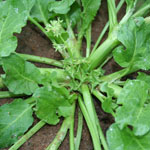Spiny emex
Common name:
- Spiny emex
Scientific name:
- Emex australis Steinh.
Other common names:
- Three-corner jack
- Double gee
Plant status
Catchment management authority boundaries
Regionally prohibited in the Wimmera, Port Phillip and Western Port catchments.
Regionally controlled in the Mallee, Goulburn Broken and North East catchments.
Restricted in the Glenelg Hopkins, West Gippsland, North Central, East Gippsland and Corangamite catchments.
Plant biology
Appearance
Herbaceous plant — Forb (flowering herbaceous plant — not a grass)
Description
Spiny emex is a semi-prostrate annual herb.
Stems
Most stems of spiny emex are prostrate but some become erect when growing among tall plants and may grow to 50cm long. Several stems grow from each crown. They are mostly hairless, ribbed, fleshy and purplish in colour at the base and at the nodes.
Leaves
Spiny emex leaves are triangular to ovate, 3 to 12cm long and 2 to 10cm wide. They are mostly hairless with undulate margins.
Lower leaves grow on long stalks while others grow on stalks at similar length or shorter than the leaf blades. Each leaf stalk is surrounded by a membranous sheath at the base.
Flowers
Male and female flowers of spiny emex are separate on the same plant and not conspicuous. Male flowers are in small stalked clusters, while the female flowers are almost sessile (attached directly to its base without a stalk) in the leaf axils.
Fruit
Spiny emex fruit changes from green to brown as it ripens.
Fruit is hard and woody, 7 to 11mm long, triangular in longitudinal cross-section — narrowed at the base, each angle extending into a rigid, sharp spine with 4 pits on each face.
Growth and lifecycle
Method of reproduction and dispersal
Infestations of spiny emex can be very dense. The fruit is well equipped for dispersal. No matter how it lies on the ground one spine always points upwards, attaching it to almost anything that passes over or is placed on it, particularly shoes, rubber tyres, feet of animals or containers of produce.
These methods have the ability to spread the seeds over distances of 200m. New infestations are likely to appear first along tracks, around buildings and at stock watering points.
Seedbank propagule persistence
The fruit from the Spiny emex has a long lifespan in the soil (more than 4 years) but very few seedlings emerge from 10cm deep. Seed from fruit on the soil surface germinates less readily than those covered with 1cm of soil.
Individual plants can produce up to 1100 seeds. Although germination can vary markedly from year to year, the total number of seeds in the soil remains relatively constant.
Preferred habitat
Spiny emex prefers sub-humid and semi-arid tropical, sub-tropical and temperate regions mainly on sandy and loamy soils. It has become widespread as a weed of grazing and cropping lands, saleyards, vineyards and neglected areas.
It is tolerant of dry conditions.
Distribution
In Victoria, spiny emex occurs in small patches of limited distribution in lowland grassland and grassy woodland areas. It is common along the Murray River irrigation areas as well as in some cereal growing districts and town areas.
Growth calendar
The icons on the following table represent the times of year for flowering, seeding, germination, the dormancy period of spiny emex and also the optimum time for treatment.
| Jan | Feb | Mar | Apr | May | Jun | Jul | Aug | Sep | Oct | Nov | Dec | |
|---|---|---|---|---|---|---|---|---|---|---|---|---|
| Flowering | ||||||||||||
| Seeding | ||||||||||||
| Germination | ||||||||||||
| Dormancy | ||||||||||||
| Treatment |
Impact
Impact on ecosystems and waterways
Spiny emex is mainly a weed of cultivated areas. The fruit from the plant can harm domestic animals, particularly dogs, and has the potential to harm native fauna.
Agricultural and economic impacts
Infestations of spiny emex can be very dense. An infestation of about 11 plants per square metre reduces wheat yields by almost 40 per cent, resulting in a major impact on the quantity of produce. With the potential to seriously affect agricultural production, the weed's presence can have a large impact on land value.
Produce contaminated with spiny emex leads to rejected loads at silos, rejected dried fruit, pulse grains, barley, peas, lupins and chickpeas.
Social value and health impacts
Spines from spiny emex can cause discomfort and inconvenience to humans, particularly when bare-footed.
Management
Prescribed measures for the control of noxious weeds:
- application of a registered herbicide
- physical removal.
Read about prescribed measures for the control of noxious weeds.
Other management techniques
Changes in land use practices and spread prevention may also support spiny emex management after implementing the prescribed measures.